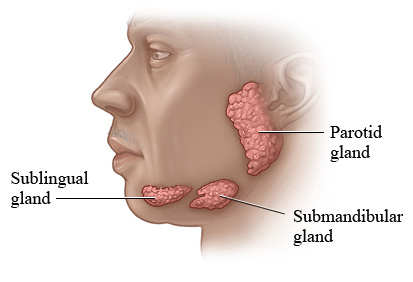The salivary glands are exocrine glands that produce saliva through a system of ducts. Humans have three paired major salivary glands (parotid, submandibular, and sublingual), as well as hundreds of minor salivary glands. Salivary glands can be classified as serous, mucous, or seromucous (mixed).
Parotid Gland
- Enters mouth via Stenson’s duct
- serous, amylase for digestion of starch
Submandibular Gland
- 65-70% of saliva production
- Enters mouth via Wharton’s duct
- mixture of serous fluid and mucus
- Due to the tortuosity of the Wharton’s duct, as well as the character of the submandibular saliva, the submandibular gland is the most common salivary gland to develop stones.
Sublingual Gland
- Mainly mucus production
- 5% of saliva production
- Exits directly from 8-20 excretory ducts known as the Rivinus ducts

Salivary Fistula
- Most salivary fistulas resolve within 2 to 3 weeks without intervention. As such, a wound exploration is not necessary. Aspiration of the area will not resolve the fistula, as saliva will continue to be formed. Prescribing an anticholinergic agent such as Robinol is not initially indicated, but may play a role in the management of a chronic salivary fistula.
